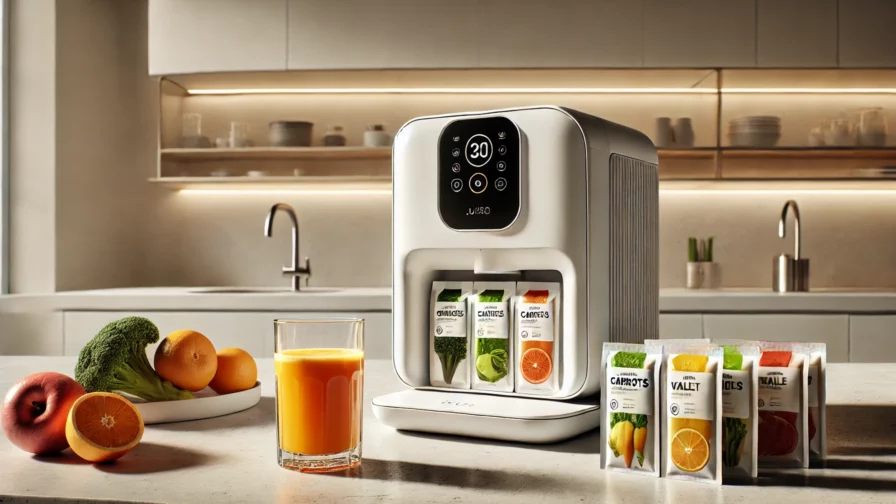
Over the past few years, the tech world has seen its share of groundbreaking innovations — but also a fair number of spectacular failures. One of the most infamous of these is Juicero, a California-based startup founded in 2013 by Doug Evans. His goal? To change the way people make fresh juice at home.
If Juicero became a symbol of “over-engineering”, then it’s only fair to mention another notorious Silicon Valley failure: Theranos. Founded by Elizabeth Holmes, Theranos promised to revolutionize blood testing but was later exposed as a large-scale fraud. While the two companies operated in different industries, they shared a common thread: the pursuit of “innovation at any cost”—even when the need for that innovation was questionable and the technology behind it wasn’t up to the task.
The Juicero press
Juicero’s main product, the Juicero Press, was a high-tech, sleek-looking machine designed to cold-press juice from pre-packaged pouches. These pouches, produced exclusively by Juicero, contained freshly cut fruits and vegetables. The process was supposed to be simple: insert the pouch, press a button, and within minutes, you’d have a fresh, natural juice — no mess, no hassle, no effort.
The concept was a hit in Silicon Valley, where the Juicero Press was often called “the Nespresso of juice”. The promise was clear: an easy, clean, and fully automated juicing experience. Just like Nespresso had made coffee brewing simple and elegant, Juicero aimed to do the same for fresh juice.
But Juicero didn’t just aim to make juicing easier — it aimed to create a whole new consumer need. Before Juicero, making fresh juice was seen as a slightly messy but manageable process. People didn’t necessarily see it as a “problem” in need of a solution. But Juicero’s marketing machine worked overtime to convince consumers that they needed a simpler, more hygienic, and more “modern” way to juice. It framed the Juicero Press as an essential tool for a health-conscious, tech-savvy lifestyle.
The pitch worked — at least for a while. Investors loved the idea, and Silicon Valley poured over $120 million into Juicero, with backing from big names like GV (Google Ventures) and Kleiner Perkins.
When the Juicero Press launched in March 2016, it was priced at a whopping $699, which raised a few eyebrows for a kitchen appliance. By January 2017, with sales falling short of expectations, the price was cut to $399, but even that failed to drive significant growth.
The tech behind the hype
On paper, the Juicero Press was a marvel of mechanical precision. It was designed to apply immense pressure to squeeze juice from the pre-packaged pouches. The machine had high-precision parts, safety sensors, and even a Wi-Fi connection.
One of the machine’s most hyped features was its pressing power. According to Doug Evans, the Juicero Press could apply enough force to “lift two Teslas”. This claim was repeated in numerous media outlets as a symbol of the machine’s strength and sophistication. While it was certainly impressive from an engineering standpoint, it ultimately turned out to be more of a marketing gimmick than a practical necessity.
The Wi-Fi connectivity was another feature that drew attention. The machine could receive firmware updates and scan QR codes on the juice pouches to verify their freshness and authenticity. The goal was to ensure that only fresh, compliant pouches were used. But this feature backfired. Critics and customers alike questioned the need for Wi-Fi on a juice press, with many sarcastically asking, “Do I really need Wi-Fi to squeeze a juice pouch?”
Then there was the mechanical complexity of the device. Juicero was much more complicated than a regular citrus juicer or blender. Its marketing materials emphasized the industrial-grade precision engineering of the device, comparing it to machinery found in large-scale production facilities. This image helped position the Juicero Press as a luxury, high-tech gadget, but in reality, despite all its sophistication, its main function was still just to squeeze a bag of juice.
The Bloomberg bombshell: why buy it when you can squeeze it?
In April 2017, Juicero’s fate was sealed by a report from Bloomberg. In a now-infamous article, Bloomberg journalists exposed the Juicero Press as being, well… completely unnecessary.
The report revealed that the pre-packaged pouches could be squeezed by hand just as easily as they could by the $699 machine. In fact, the amount of juice produced by hand was virtually identical to the juice produced by the machine.
This revelation called into question the very reason for the Juicero Press’s existence. Why spend $699 (or even $399) on a machine when you could just squeeze the pouch with your hands? Bloomberg’s videos and images of employees squeezing the pouches by hand went viral, sparking a wave of internet mockery.
The backlash was fierce. Consumers, tech enthusiasts, and critics all mocked Juicero for its absurdity. Memes, parodies, and jokes flooded social media, and Juicero quickly became a punchline for everything wrong with the “tech for tech’s sake” mentality of Silicon Valley.
Juicero’s response: damage control mode
Juicero tried to contain the fallout. The company offered full refunds to dissatisfied customers, an attempt to salvage its image and rebuild trust. Doug Evans and the Juicero team defended the machine’s hefty price tag, arguing that it provided better hygiene, a cleaner experience, and avoided the need to touch the contents of the pouches.
But it was too little, too late. The idea that customers had paid $699 for a glorified bag-squeezer had already taken root. No amount of PR spin could undo that perception.
The end of Juicero
By September 2017, just a few months after the Bloomberg report, Juicero announced its complete shutdown. The company ceased production of the Juicero Press and began seeking buyers for its patented technology and intellectual property.
This marked the total collapse of the project, which had started with the goal of “revolutionizing the juice industry.” Despite raising over $120 million from investors, Juicero failed to prove that its product was worth its price tag or that it could generate sustainable revenue.
Lessons from Juicero: what went wrong?
Juicero’s story is a classic “cautionary tale” for startups and innovators. It highlights the risks of solving a problem that doesn’t really exist.
The biggest mistake? Juicero tried to create a sense of need where none existed. They framed the Juicero Press as a symbol of health, cleanliness, and modern living. For a while, it worked. Investors loved it. But when Bloomberg exposed the “hand-squeeze trick,” the illusion crumbled.
Juicero is often cited alongside Theranos as an example of over-engineering and over-promising. The story shows that “more tech” isn’t always “better tech.” If the core problem can be solved with your bare hands, you probably don’t need a $699 gadget to do it.
Today, Juicero is remembered as one of the most iconic tech flops of Silicon Valley. But for many, it’s also a learning opportunity — a reminder that even with $120 million in funding, a bad idea is still a bad idea.

